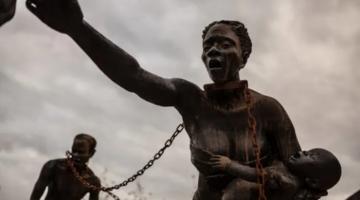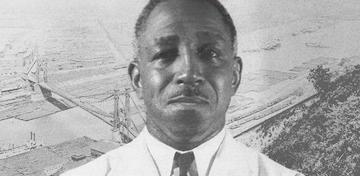Toni Morrison on art, archives, knowledge, and the long history of white supremacy in the United States.
As the United States furiously reaffirms itself as a white supremacist homeland, and all signs and symbols of non-white existence are expunged from history and purged from public life, novelist Toni Morrison’s lecture, “A Humanist View,” takes on a particular urgency and clarity. Morrison presented “A Humanist View” on Friday, May 30, 1975, at Portland State University as part of their Black Studies Center series “Public Dialogue on the American Dream Theme.” The audio of Morrison’s talk was preserved by the PSU Library Special Collections and University Archives and can be found here.
It is from “A Humanist View” that one of Morrison’s better known quotations on racism is drawn: “the function, the very serious function of racism… is distraction. It keeps you from doing your work.” Yet to distill this one line from the lecture is to miss Morrison’s deeper structural analyses and critiques – not to mention the astonishingly powerful and incisive language through which she builds her arguments. For “A Humanist View” only gets to the notion of “racism as distraction” after a slow, at times harrowing, archival journey into the long history of white supremacy in the United States. Morrison reads the U.S. Census bureau’s massive and thorough compilation, The Historical Statistics of the United States from Colonial Times to 1957 to demonstrate the technocratic erasure of Black life in US history. She turns to a damning set of quotations from “great men” to evidence the everyday savagery of whiteness and their racism towards Black people, as well as indigenous people, Asians, and Jews.
Morrison also castigates the academic disciplines – history, anthropology, urban studies, sociology—to show how, from their very foundations, they have been the sources of racist misrepresentation as well as perpetrators of a crippling of intelligence and imagination. While all of this led to distraction – forcing Black folk to continually prove themselves and their humanity, to whites – for Morrison, the motivation was greed, “profit and money.”
Today, the U.S. whites are trying to re-establish the rule of the “great [white] men” – as if white supremacist rule had ever receded. And, in the process, U.S. universities and other institutions are happily removing the thin white hoods to reveal their foundationally racist ways. And the pursuit of profit has reached new, cynical heights. This new moment will also bring new forms of distractions. But as Morrison tells us, to be free, “You don’t waste your energy fighting the fever; you must only fight the disease.”
A Humanist View
Toni Morrison
Thank you very much. Right after “pitch” and “rice,” but before “tar” and “turpentine,” there is listed the “human beings.” The rice is measured by pounds, and the tar and turpentine is measured by the barrel weight. Now, there was no way for the book, entitled The Historical Statistics of the United States from Colonial Times to 1957, to measure by pound or tonnage or by barrel weight the human beings. They used only head count. The book that I’m referring to, Historical Statistics of the United States, is full of fascinating information, not the least of which is a series labeled “Z,” 281-303, which documents in chronological order, and by point of destination and import, and export, those humans who came to the United States from 1619 to 1769.
It seems that every effort was made in compiling these charts and graphs and lists, to assure accuracy. Underneath the neat little columns of figures are footnotes for whenever there is some equivocation, or some number that the Census Bureau is not quite sure of, they identify the fact that it is incomplete. “We are very sorry,” they seem to say, “that our information is not complete, you understand, the country was just getting itself together, and we did not have expert means of collecting data; things were not very efficient then.” And you can sense the reasonableness in the gentlemanly assertion everywhere in those pages.
But it is a reasonable list without the least hope of success, because the language cracks under the weight of its own implication. Footnote 3, for example, under Slaves, clarifies the ambiguity of its reference with the following words: “Source shows 72 Indians imported; of that [...] number 231 slaves died and 103 were drawn back for exportation.” “Died” and “drawn back” are very strange words to find in an index of imports and exports. They are words that you can never use to describe rice. Footnote 5 is very civilized. It says, “Number of Negroes shipped, not those who actually arrived.” There was a difference, apparently, between the number shipped and the number that actually arrived. Then the mind gallops over to the first unanswered question: How many? How many were shipped, and how many did not arrive? And then, one thinks about the next question, the really vital question that withers all of the others. Who? Who was absent at the final head count? Was there a seventeen-year-old girl there? With a tree-shaped scar on her knee? And what was her name? We say, Please, Mr. Inspector General of the United States Census Bureau, what was her name?
Historical statistics, however, are not required, are certainly not expected to provide that kind of information. Its job is done and very well done, and 153 years of Black history is dispatched on page 769 and 770, which is about twice the amount of space devoted to rice. Now that’s simply what economic indices are like. But it’s also very frequently what American history’s concept of Blacks is like. It certainly isn’t the fan-shaped spread of rice bursting from a gunny sack. It’s not the thunder roll of barrels of turpentine cascading down a plank. It’s not a seventeen-year-old girl with a tree-shaped scar on her knee, and a name. Pretty much like the historical statistics, is Black American history. A separate book, a separate chapter, or a separate section on the origins and consequences of slavery. All of which is related to production and legislation, and very seldom to the very fabric of life and culture in this country.
History is percentiles, history is the thoughts of great men, and the description of eras. Does the girl know that the reason that she died in the sea or was smothered in a sixty-foot slop pit on a ship named “Jesus” was because that was her era, or that some great men thought of her destiny as part of a percentage of national growth, or expansion, or pre-industrial revolution, or colonization of a new world? Does she know what part she played in the minds of great men?
I’d like for you to listen for just a minute to some of the words of this country’s great, great men. In December of 1833, Andrew Jackson wrote the following: “Indians have neither the intelligence, the industry, the moral habits, nor the desire of improvement which are essential to any favorable change in their condition. Established in the midst of another and a superior race, and without appreciating the causes of their inferiority or seeking to control them, they must necessarily yield to the force of circumstances, and ere long, disappear.”
General William Sherman: “We must act with vindictive earnestness against the Sioux, even to their extermination, men, women, and children. Nothing else will reach the root in this case. The more we can kill this year, the less will have to be killed in the next war. For the more I see of these Indians, the more convinced I am that all have to be killed, or maintained as a species of pauper.”
In 1854, the New York Tribune editorialized as follows: “The Chinese are uncivilized, unclean, filthy beyond all conception, without any of the higher domestic or social relations; lusty and sensual in their dispositions, every female is a prostitute of the basest order.”
Richard Pike, Boston, 1854: “Catholicism is, and it ever has been, a bigoted, persecuting, and superstitious religion. There is no crime in a calendar of infamy of which it has not been guilty. There is no sin against humanity that it has not committed. There is no blasphemy against God which it has not sanctioned. It is a power which has never scrupled to break its faith’s solemn piety wherever its interests seem to require it, which has no conscience, which spans the control of public opinion, which obtrudes its head among the nations of Christendom, dripping with the cruelties of millions of murders, and haggard with the debaucheries of a thousand years, always ambitious, always sanguinary, and always false.”
Sam Houston, 1848, he addressed the United States Senate. His words: “The Anglo-Saxon must pervade the whole southern extremity of this vast continent. Mexicans are no better than the Indians, and I see no reason why we should not take their land.”
Ulysses S. Grant, LaGrange, Tennessee, 1862: “An order to Major General Hurlbut, Jackson, Tennessee. Refuse all permits to come south of Jackson for the present. The Israelites, especially, should be kept out.”
December 8, General Grant, 1862, to General Webster. “Give orders to all the conductors on the road that no Jews are to be permitted to travel on the railroad south from any point. They may go north and be encouraged in it, but they are such an intolerable nuisance that the department must be purged of them.” A general order from Ulysses Grant. “On account of a scarcity of provisions, all cotton speculators, Jews, and other vagrants having no honest means of support except trading upon the misery of the country...”
More recently, Theodore Roosevelt, 1901; he speaks to Owen Lister: “I entirely agree with you that as a race, and in the mass, the Negroes are altogether inferior to whites.”
And then, finally, a few judicious excerpts from the diary of William Byrd of Virginia, 1710 to 1712. The editor of his diary described Byrd as Virginia’s most polished and ornamental gentleman, a kindly master who inveigled in some of his letters against “brutes who mistreat their slaves.”
“2/8. Jenny and Eugene were whipped.
4/17. Anaka was whipped.
5/13. Mrs. Byrd whips the nurse.
5/23 Moll was whipped.
6/10 Eugene, a child, was whipped for running away, and had the bit put on him.
9/3 I beat Jenny.
9/16 Jenny was whipped.
9/19 I beat Anama.
11/30 Eugene and Jenny were whipped.
12/16 Eugene was whipped for doing nothing yesterday.
7/1 A Negro woman ran away again with a bit on her mouth.
7/8 The Negro woman was found and tied, but ran away again in the night.
7/15 My wife, against my will, caused little Jenny to be burnt with a hot iron.
8/22 I had a severe quarrel with little Jenny and beat her too much, for which I was sorry.
8/31 Eugene and Jenny beaten.
10/8 I whipped three slave women.
11/6 The Negro woman ran away again.
11/13 The Negro woman fugitive was found dead.
1/11 A quarrel with my wife for being cruel to Brayne.
1/22 A slave pretended to be sick, but I put a branding iron on the place he complained of and put the bit on him.
2/2 My wife and little Jenny had a great quarrel in which my wife got the worst, but at last by the help of the family, Jenny was overcome and soundly whipped.
3/20 I beat a Negro woman.
4/30 I had two male slaves beaten.
5/1 I caused Prue to be whipped severely.
8/4 I was indisposed with the beating of Prue, and tired.
9/26 I had several people whipped.
9/28 Eugene pretend he fell and hurt himself; he is forced to wear the bit for 24 hours.
2/5 My wife causes several slaves to be whipped.
3/2 My wife beats Jenny with the tongs. I disapprove.
3/3 Billy is beaten.
3/15 Peter again claims to be ill, and the bit is put in his mouth once more.
4/9 My wife causes Molly to be whipped.
5/22 My wife beats Prue very violently; I whip Anama severely.
6/6 Found Prue with a candle by daylight, for which I gave her a salute with my foot.
6/30 Three women and one man are beaten.
7/25 Billy is whipped.
7/30 Molly and Jenny are whipped.
8/21 Billy, beaten.
9/3 My wife gave Prue a great whipping.”
And at last, Benjamin Franklin. “Why increase the sons of Africa by planting them in America, where we have so fair an opportunity, by excluding all the Blacks and Tawnies, and increasing the lovely White and Red?”
Those great men said other things. But they also said that. No one can blame the conqueror for writing history the way he sees it, and certainly not for digesting human events and discovering their patterns according to his own point of view. But it must be admitted that conventional history supports and complements a very grave and a very serious, almost pristine ignorance. Because the very nature of history is to make large distinctions. It encourages the intellect, therefore, to forgo finer ones. Because historians must deal with rice in bulk, rather than grain by grain, heavy dependence on the conventions of that discipline lead us to do likewise in human relationships.
If such history continues to be the major informer of our sensibilities, we will remain functionally unintelligent. After all, it is the ability to make distinctions, and the smaller the distinctions made, the higher the intellect that makes them, by which we judge intellect. We judge intellect in several ways. One of the most important is by the ease with which it can tell the difference between one molecule and another, one cell and another. Between a 1957 Bordeaux wine and a 1968. Between the color mauve and orchid. Between the words “wrest,” w-r-e-s-t, and the word “pry” p-r-y. The difference between butter and clabber, buttermilk and clabber. Between Chanel number 5 and Chanel 16th.
So it would seem that to continue to see a race of people, any race of people, as one single personality, is an ignorance of gothic proportions. An ignorance so vast, so public, a perception so blind and so blunted, imagination so bleak that no nuance, no subtlety, no difference among them can be ascertained. Which may explain in part why in 1975, we are left with pretty much the same mental equipment we had in 1775. The equipment that hadn’t the curiosity to record the names of human beings in a ship’s manifest hasn’t the curiosity to examine the medieval minds of scientific racists, theologic racists, historical racists, literary racists. An intelligence that is so crippled that it could, in all seriousness, ask W.E.B. Du Bois in 1905, in pursuit of some study as a white professor from Clark University did, whether or not colored people shed tears. It’s the same crippled intelligence that grants foundation money to educational careerists to study the cause of riots, as opposed to racism; to study the genetic influences on intelligence of a race that is so mixed, genetically mixed, that the experiment should fall apart at step one. In spite of improved methods of collecting and storing data, and increased amounts of data available, with the exception of the deep probe of three or four historians, American scholarship has done virtually nothing to erase the ignorance that I have described.
On the contrary, studies designed to confirm old prejudices and create new ones are really on the increase. Of the several areas of ignorance, those concerning Black people and their relationship to this country are still, at least to me, the most shocking. Some of the ignorance, of course, is willful. Some is simply the consequence of boredom that accompanies all mention of ethnic pride in anybody other than oneself. Most, however, is the fault of the disciplines that cannot or will not accommodate cultures outside the mainstream, or examine interrelationships between co-existent cultures. If education is about anything other than being able to earn more money, that other thing is intelligent problem-solving and humans relating to each other in mutually constructive ways. If it was homicidal in 1674 to limit the truth and to embalm the intellect in that way, it is certainly suicidal in 1975.
History, the social sciences, and the humanities are the chief carriers of this malignancy. Any one of those studies, if it was honest, would acknowledge the fact that the major part of the history of this country is the history of the minorities and the Black people in it, how they influenced those who were first, and how they influenced each other. The economic history of this country is, among other things, the study of generations and generations of free labor used to make the country grow. The legal history of this country is very heavily weighted with the court, particularly the Supreme Court’s relation to Black people. And the legislation designed specifically, deliberately, to keep them oppressed.
Anthropology is the study of the colored peoples of the world. They don’t study anybody else. Social studies itself was founded and funded by the Mellons and the Carnegies and those people who were interested in the deviants who were not like them. It got its first money from those people, and they never studied themselves. Urban studies is the study of Black people. And the approach vigorously held to in these studies: Blacks as wards of the state, never as its pioneers. It does take two to hold a chain. The chained and the chainer. And it takes two to make anthropology: the student and the studied. And although no group in the world has had more money spent on it to have its genetics examined, its fecundity stopped, its intelligence measured, cross-acculturation is consistently neglected, and I would like to know who are these people who know our sperm count, but they don’t know our names?
That being the case, it is time, way past time, for the study to examine the student, and to evaluate its own self. And the fruit should be of immense value to us, to all of us. And the first job for the scholar and particularly for the artist is to destroy the source of that mindlessness, to focus on the hysteria and greed of those whose business it is to manipulate us and keep us anonymous or peripheral to events of this country.
The second responsibility of artists and scholars is to bear down hard on those generalities: the statistics and the charts, and to make them give up the life they are hiding. Racial apologists would have us believe that Black children have to sit in a room with white children to learn anything. That Blacks have to go to Harvard Business School before they can open up a grocery store. That Blacks have to read Descartes to be literate, in spite of the fact that the New York Times is written and has always been written on a sixth-grade level. And that the ego of Black people is a thread of jelly, needing constant cement.
More important, accurate scholarship and free, dedicated artists would reveal a singularly important thing. That racism was and is not only a mark, a public mark, of ignorance, it was and is a monumental fraud. Racism was never, ever the issue. Profit and money always was. In all of those quotations, from William Byrd to Benjamin Franklin and Andrew Jackson to the New York Tribune, the threat was always jobs, land, or money. And when you really want to take away, to oppress, and to prevent, you have to have a reason for despising your victim. Where racism exists as an idea, it was always a confidence game that sucked all the strength of the victim. It really is the red flag that the toreador dances before the head of a bull. Its purpose is only to distract, to keep the bull’s mind away from his power and his energy; to keep his mind focused on anything but his own business. Its hoped-for consequence was to define Black people as reactions to white presence. Nobody really thought that Black people were inferior. Not Benjamin Franklin, not Mr. Byrd, and not Theodore Roosevelt. They only hoped that they would behave that way. They only hoped that Black people would hear “coon” songs, disparaging things, and would weep, or kill, or resign, or become one. They never thought Black people were lazy, ever. Not only because they did all the work, but they certainly hoped that they would never try to fulfill their ambitions.
And they never, ever thought we were inhuman. You don’t give your children over to the care of people whom you believe to be inhuman, for your children are all the immortality you can expect. Your children are the reason you work, or plot, or steal. Racists were never afraid of sexual power or switchblades. They were only, and simply, and now interested in the acquisition of wealth, and the status quo of the poor. Everybody knows that if the price is high enough, the racist will give you whatever you want.
It’s important, therefore, to know who the real enemy is, and to know the function, the very serious function of racism, which is distraction. It keeps you from doing your work. It keeps you explaining over and over again your reason for being. Someday says you have no language, so you spend twenty years proving that you do. Somebody says your head isn’t shaped properly, so you have scientists working on the fact that it is. Somebody says that you have no art, so you dredge that up. Somebody says that you have no kingdoms, so you dredge that up. None of that is necessary. There will always be one more thing. The distraction is no different from bombing Cambodia to keep the North Vietnamese from making their great push.
And since not history, not anthropology, not social sciences, seem capable in a strong and consistent way to grapple with that problem, it may very well be left to the artists to do it. For art focuses on the single grain of rice, the tree-shaped scar, and the names of people, not only the number that arrived. And to the artists, one can only say not to be confused. Not to be confused. You don’t waste your energy fighting the fever, you must only fight the disease. And the disease is not racism; it is greed and the struggle for power. And I urge you to be careful, for there is a deadly prison, a prison that is erected when one spends one’s life fighting phantoms, concentrating on myths, and explaining over and over to the conqueror your language, your lifestyle, your history, your habits, when you don’t have to do it anymore; you can go ahead and talk straight to me.
To avoid the prison of reacting to racism is a problem of the very first order. Where the mind dwells on changing the minds of racists is a very dank place. Where the spirit hangs limp in the silk cords of the racial apologists who want soft and delicate treatment for the poor victims is a very dim place. Where the will that you allow to be eroded, day by day, day by day by consistent assault of racists, then the will just settles into a tiny little heap of sand. Then you just have a second-rate existence, jammed with second-rate ideas. Racial ignorance is a prison from which there is no escape, because there are no doors.
There are old, old men and old, old women running institutions of government, homes all over the world who need to believe in their racism and need to have the victims of racism concentrate all their creative abilities on them. They are very easily identified; they are the petulant ones who call themselves “proud,” and they are the disdainful ones who call themselves “fastidious,” and they are the mean-spirited ones who call themselves “just.” They thrive on the failures of those unlike them. They are the ones who measure their wealth by the desperation of the poor. They are the ones who know personal success only when they can identify deficiencies in other racial and ethnic groups. They are in prisons of their own construction, and their ignorance and stunted emotional growth consistently boggle the mind.
But the artist knows that we are human, and the artist knows if he is free, exactly what every three-year-old child knows, that the whole business of reproducing and dying by the billions is unsatisfactory and clumsy. He also knows that we have not yet encountered any god who is as merciful as one Black man who flips a beetle over on his feet. There’s not a race in the world that behaves as badly as preying mantises. We are the moral inhabitants of the globe, and to deny it is to lie in prison. Oh yes, there is cruelty, and cruelty, because it destroys the perpetuator as well as the victim, is a very mysterious thing. But if you look at the world as one long, brutal game between “us” and “them,” then you bump into another mystery. And that is the mystery of the tree-shaped scar, and the canary that might sing on the crown of a skull. And unless all ages and all races of man have been totally deluded, there seems to be such a thing as grace, such a thing as beauty, such a thing as harmony. All of which are wholly free and available to us. Thank you very much.
Toni Morrison, “A Humanist View,” May 30, 1975, from Toni Morrison, Primus St. John, John Callahan, Susan Callahan, and Lloyd Baker, "Black Studies Center Public Dialogue, Part 2" (1975). Special Collections: Oregon Public Speakers, Portland State University Library Special Collections and University Archives



















